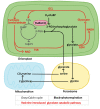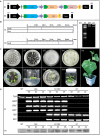Introduction of Exogenous Glycolate Catabolic Pathway Can Strongly Enhances Photosynthesis and Biomass Yield of Cucumber Grown in a Low-CO2 Environment
- PMID: 31191593
- PMCID: PMC6549358
- DOI: 10.3389/fpls.2019.00702
Introduction of Exogenous Glycolate Catabolic Pathway Can Strongly Enhances Photosynthesis and Biomass Yield of Cucumber Grown in a Low-CO2 Environment
Abstract
Carbon dioxide (CO2) is very important for photosynthesis of green plants. CO2 concentration in the atmosphere is relatively stable, but it drops sharply after sunrise due to the tightness of the greenhouse and the absorption of CO2 by vegetable crops. Vegetables in greenhouses are chronically CO2 starved. To investigate the feasibility of using genetic engineering to improve the photosynthesis and yield of greenhouse cucumber in a low CO2 environment, five genes encoding glyoxylate carboligase (GCL), tartronic semialdehyde reductase (TSR), and glycolate dehydrogenase (GlcDH) in the glycolate catabolic pathway of Escherichia coli were partially or completely introduced into cucumber chloroplast. Both partial pathway by introducing GlcDH and full pathway expressing lines exhibited higher photosynthetic efficiency and biomass yield than wild-type (WT) controls in low CO2 environments. Expression of partial pathway by introducing GlcDH increased net photosynthesis by 14.9% and biomass yield by 44.9%, whereas the expression of the full pathway increased seed yield by 33.4% and biomass yield by 59.0%. Photosynthesis, fluorescence parameters, and enzymatic measurements confirmed that the introduction of glycolate catabolic pathway increased the activity of photosynthetic carbon assimilation-related enzymes and reduced the activity of photorespiration-related enzymes in cucumber, thereby promoting the operation of Calvin cycle and resulting in higher net photosynthetic rate even in low CO2 environments. This increase shows an improvement in the efficiency of the operation of the photosynthetic loop. However, the utilization of cucumber of low concentration CO2 was not alleviated. This study demonstrated the feasibility of introducing the pathway of exogenous glycolate catabolic pathway to improve the photosynthetic and bio-yield of cucumber in a low CO2 environment. These findings are of great significance for high photosynthetic efficiency breeding of greenhouse cucumber.
Keywords: Cucumber; glycolate catabolic pathway; high-photosynthetic-efficiency; low-CO2 treatment; multigene co-overexpression.
Figures








Similar articles
-
Multigene manipulation of photosynthetic carbon metabolism enhances the photosynthetic capacity and biomass yield of cucumber under low-CO2 environment.Front Plant Sci. 2022 Oct 18;13:1005261. doi: 10.3389/fpls.2022.1005261. eCollection 2022. Front Plant Sci. 2022. PMID: 36330244 Free PMC article.
-
A chloroplast Glycolate catabolic pathway bypassing the endogenous photorespiratory cycle enhances photosynthesis, biomass and yield in rice (Oryza sativa L.).Plant Sci. 2022 Jan;314:111103. doi: 10.1016/j.plantsci.2021.111103. Epub 2021 Nov 1. Plant Sci. 2022. PMID: 34895540
-
A photorespiratory bypass increases plant growth and seed yield in biofuel crop Camelina sativa.Biotechnol Biofuels. 2015 Oct 29;8:175. doi: 10.1186/s13068-015-0357-1. eCollection 2015. Biotechnol Biofuels. 2015. PMID: 26516348 Free PMC article.
-
Suppressing photorespiration for the improvement in photosynthesis and crop yields: A review on the role of S-allantoin as a nitrogen source.J Environ Manage. 2019 May 1;237:644-651. doi: 10.1016/j.jenvman.2019.02.082. Epub 2019 Mar 11. J Environ Manage. 2019. PMID: 30870683 Review.
-
Photorespiratory glycolate-glyoxylate metabolism.J Exp Bot. 2016 May;67(10):3041-52. doi: 10.1093/jxb/erw090. Epub 2016 Mar 19. J Exp Bot. 2016. PMID: 26994478 Review.
Cited by
-
Synthetic photorespiratory bypass more stably increases potato yield per plant by improving photosynthesis.Plant Biotechnol J. 2025 Jul;23(7):2526-2536. doi: 10.1111/pbi.70076. Epub 2025 Apr 2. Plant Biotechnol J. 2025. PMID: 40176370 Free PMC article.
-
Multigene manipulation of photosynthetic carbon metabolism enhances the photosynthetic capacity and biomass yield of cucumber under low-CO2 environment.Front Plant Sci. 2022 Oct 18;13:1005261. doi: 10.3389/fpls.2022.1005261. eCollection 2022. Front Plant Sci. 2022. PMID: 36330244 Free PMC article.
-
Two glyoxylate reductase isoforms are functionally redundant but required under high photorespiration conditions in rice.BMC Plant Biol. 2020 Jul 29;20(1):357. doi: 10.1186/s12870-020-02568-0. BMC Plant Biol. 2020. PMID: 32727356 Free PMC article.
-
Biosynthetic approaches to efficient assimilation of CO2 via photorespiration modification in plant chassis.Front Bioeng Biotechnol. 2022 Aug 8;10:979627. doi: 10.3389/fbioe.2022.979627. eCollection 2022. Front Bioeng Biotechnol. 2022. PMID: 36003537 Free PMC article. Review.
-
The era of cultivating smart rice with high light efficiency and heat tolerance has come of age.Front Plant Sci. 2022 Oct 7;13:1021203. doi: 10.3389/fpls.2022.1021203. eCollection 2022. Front Plant Sci. 2022. PMID: 36275525 Free PMC article. Review.
References
-
- Agarie S., Miura A., Sumikura R., Tsukamoto S., Nose A., Arima S., et al. (2002). Overexpression of C4 PEPC caused O2-insensitive photosynthesis in transgenic rice plants. Plant Sci. 162 257–265. 10.1016/s0168-9452(01)00572-6 - DOI
-
- Booker F. L., Reid C. D., Brunschön-Harti S., Fiscus E. L., Miller J. E. (1997). Photosynthesis and photorespiration in soybean [Glycine max (L.) Merr.] chronically exposed to elevated carbon dioxide and ozone. J. Exp. Bot. 48 1843–1852. 10.1093/jexbot/48.315.1843 - DOI
LinkOut - more resources
Full Text Sources
Molecular Biology Databases

